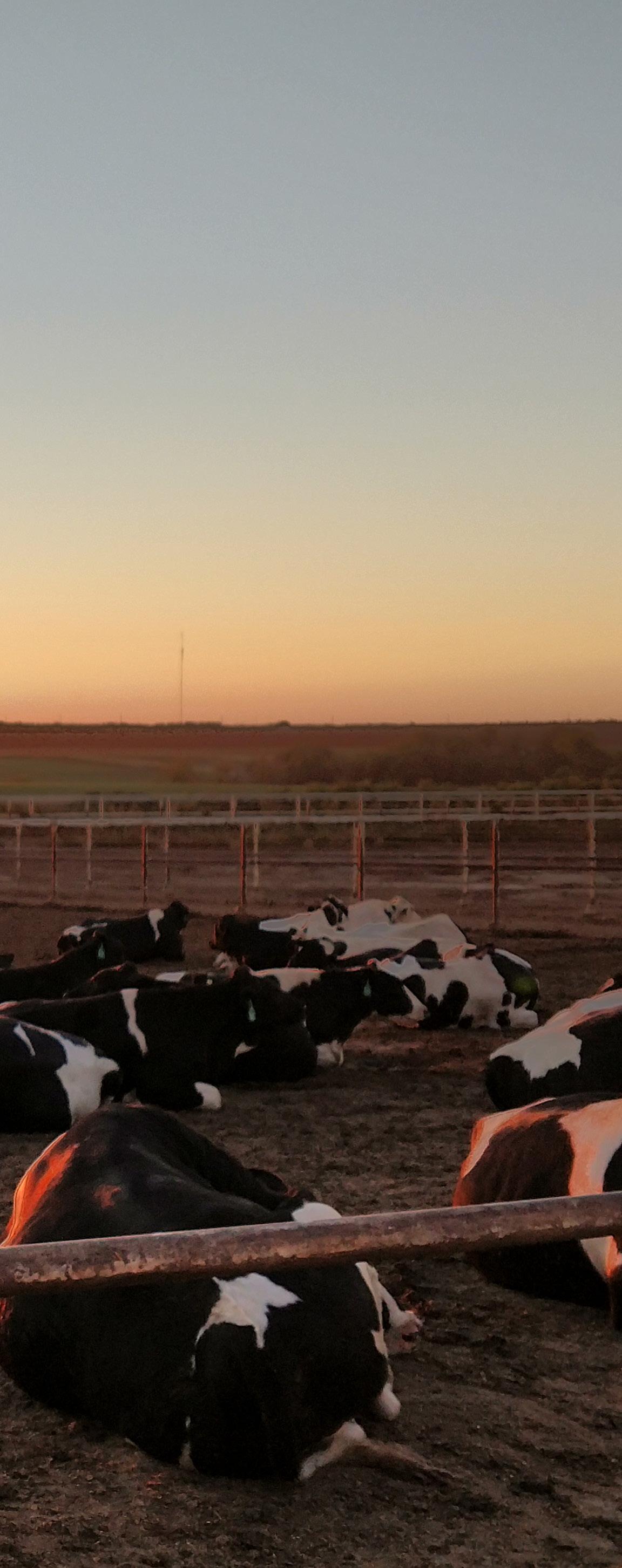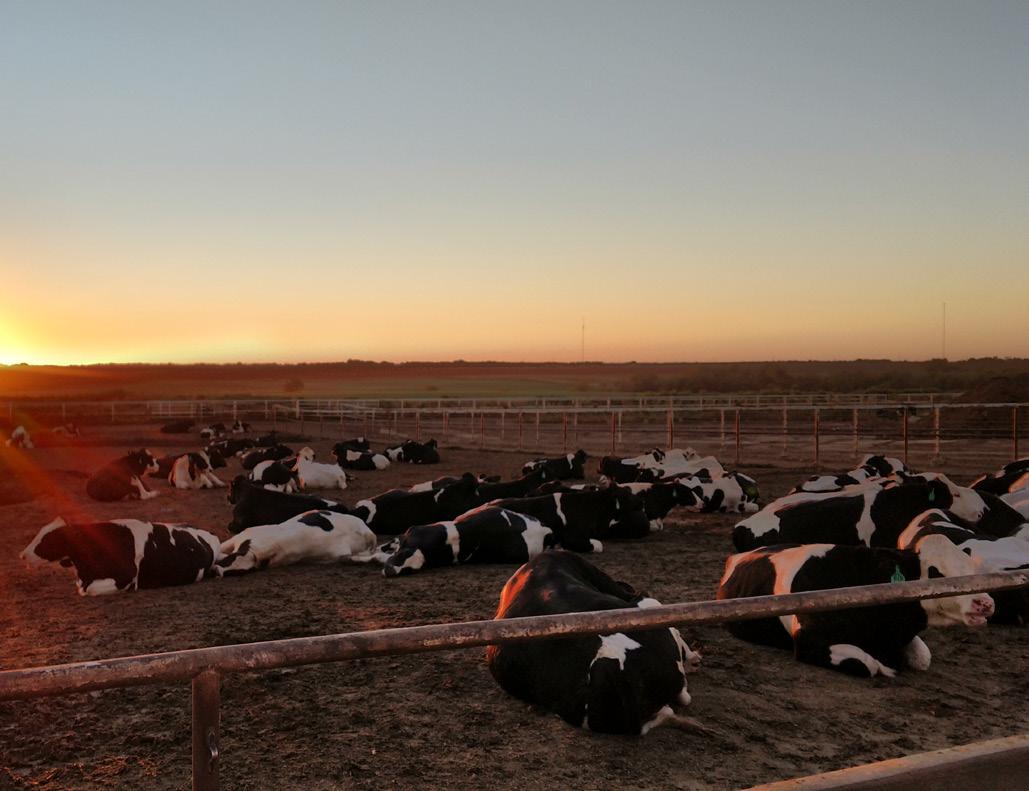
3 minute read
Wanted: Comfortable Cows
By: Jeffrey M. DeFrain, PhD, DBLACAS, Progressive Dairy Solutions, Inc.
Next to forage quality, maximizing cow comfort, regardless of housing system, is critical to unlocking greater levels of performance. Data from Bach et al. (2008) clearly demonstrates the impact of non-dietary/management factors. These authors reported a 29 lb/cow/d variation in milk yield across 47 dairy herds (approximately 3,129 cows) in Spain fed the exact same TMR. Non-dietary factors accounted for 56% of variation in milk yield and was largely associated with age at 1st calving, feeding for refusals, pushing up feed and stalls:cow (pen stocking density).
We can witness this all too often in the field where dairies or feedyards operating <10 miles of each other, fed largely the same dietary ingredients have significantly different levels of animal performance. When you take a deeper dive into how one facility is outperforming another, differences in cow comfort often stand out as the common denominator. In fact, data from Dr. Rick Grant and others at the William H. Miner Agricultural Research Institute has shown each hour of additional resting time will provide for 2.0 to 3.5 lb more milk per cow per day.
If comfortable cows are “WANTED”, and they should be, one should assess the budget of the three major daily behaviors/activities known to drive performance, health, efficiency and ultimately, cost of production. According to Dr. Rick Grant, these include:
1. Eating – generally around 5 h per day
2. Lying/resting – 12 to 14 h per day (including 6 h of ruminating)
3. Ruminating – 4 h per day while standing
4. Drinking/socializing – 1 h per day
5. Milking/travel/headlocks – less than 3 h per day
Research has shown that lying time takes precedence over eating and social behaviors. As we should expect, when rest/lying is limited, health and productivity become compromised. Lying time has been found to be closely related to the level of lameness within a herd. Focusing on management factors which may limit lying behavior will generate improved animal performance and reduce the incidence of lameness in the herd.
The objective of encouraging lying/resting is largely related to management of claw horn lesions, namely sole hemorrhage, sole ulcers and white line disease. These claw lesions are associated with damage/inflammation to the underlying corium which can be caused by hormonal changes around calving, degeneration of the digital cushion with aging and/or subacute ruminal acidosis. This damage to the corium becomes further compounded when time spent standing is increased. One classic example of this is the increase in incidence of these lesion types 60 to 90 d following heat stress where hours spent standing/d was increased. Therefore, we must commit to management factors associated with maximizing lying times and minimizing time spent standing.
There has been a great deal of research focused on management factors associated with lying behavior. Key take aways from this research include:
1. Surface: cows prefer soft, deep, clean and dry surfaces with solid traction/footing. Therefore, sand remains the gold standard for freestalls while grooming of compost/ pen maintenance of open lots dairies requires close supervision to encourage lying behavior.
2. Cows have a strong desire to maintain a consistent number of hours of rest per day. Management factors such as poor management/grooming of resting surface, poor freestall design, inadequate parlor throughput, time spent in lock-ups, overstocking and heat stress can deter cows from lying and also affect feeding behavior. Data suggests each 3.5 mins cows are deprived of rest results in a 1 min reduction in feeding time. This can further lead to changes in eating behavior (time of eating, fewer meals/d, eating rate, sorting, etc.) if feed bunk stocking density (number of cows / headlock) is already maxed.

3. House 1st lactation heifers separately from mature cows. Heifers housed separately from mature cows have greater feed intake and increased resting time. Subordinate animals are the first to be affected by changes in stocking densities.
4. Excessive time in lock-ups robs cows of lying time. Cows should not be locked up for > 2 h per day, assuming one of the hours is associated with a fresh feed delivery.
5.Standing, while waiting for a freestall to become available also presents a greater lameness factor due to more exposure of the hoof to the manure slurry. In general, stocking density must rise above 1.2 stalls per cow for lying time to decline.
6. In hot temperatures, cows spend more time standing in the alley under the fans/soakers. Consider reducing stocking densities in breeding pens and have ample fans and soakers in the holding pen and limit time in the holding pen during hot weather.
7. Depriving lying time limits blood flow to the mammary gland, generates an increase in blood cortisol and reduces levels of circulating growth hormone. Furthermore, reducing lying time negatively affects blood flowing to the fetus which affects fetal growth.
8. When considering new construction or remodels to existing facilities, always put cow comfort first, not labor efficiencies.
In summary, maximizing cow comfort and lying time will generate improved animal performance, reduce the incidence of lameness in the herd and ultimately reduce cost of production. The cow’s environment clearly influences the risk of becoming lame as well as the ability to recover from lameness. Studying cow behavior along side herd health records can enable one to paint a clear picture as to how well management is doing at creating an optimal level of cow comfort to maximize animal performance.










